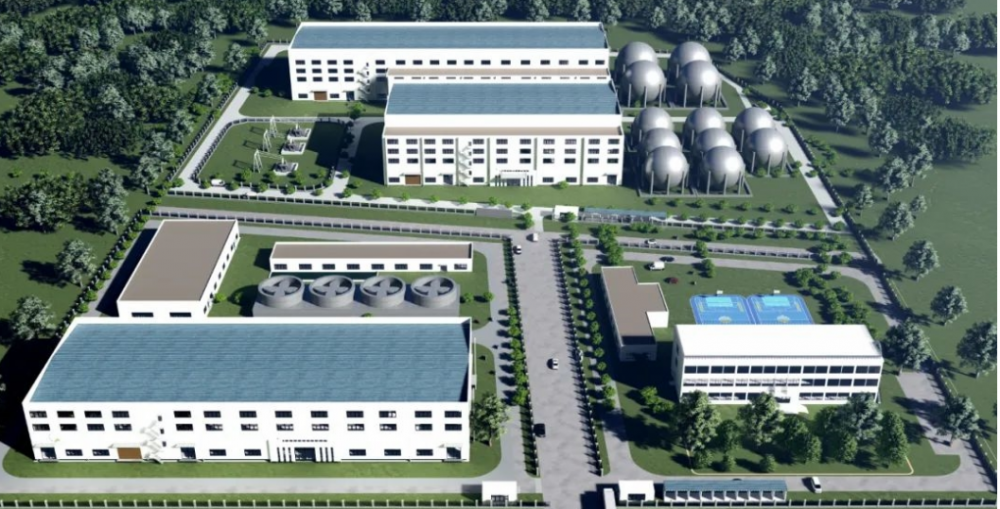Recently, reporters visited the construction site of the Zhongshang Guoneng Feicheng Compressed Air Energy Storage Demonstration Project in Tai'an, Shandong, where major projects for high-quality development are being promoted.
Planning of 300 MW /1800 MW/h compressed air energy storage project in Feicheng
Energy storage is a key technology for promoting large-scale utilization of renewable energy and ensuring the safe and stable operation of the power system. Compressed air energy storage is considered one of the most promising large-scale energy storage technologies, with many advantages such as large scale, long life, low cost, and no pollution. It has important strategic significance for improving power supply structure, enhancing grid quality, meeting peak shaving demand, and promoting new energy consumption. According to the head of the Energy Conservation and Technology Equipment Department of the Provincial Energy Bureau, compressed air energy storage technology is a new type of energy storage technology that uses compressed air as an energy storage medium to store and convert energy, enabling large-capacity energy storage. The operating principle of the technology is to compress air using a compressor during periods of low grid load, converting electrical energy into compressed potential energy and storing the compressed air in rock caves, abandoned salt mines, abandoned mines, and other pressure vessels. When the grid is under high load, the stored high-pressure gas is released, heated through a combustion chamber or heat exchanger, and then sent to a turbine expander, where the pressure potential energy and thermal energy carried by the compressed air are converted into mechanical energy output by the expander, driving the generator to generate electricity.
It is reported that the Shandong Feicheng Advanced Compressed Air Energy Storage Demonstration Project, built by Zhongshang Guoneng (Shandong) Electric Energy Co., Ltd., has a total capacity of 310 MW and is being built in two phases. The first phase, with a capacity of 10 MW, is the world's first salt cavern compressed air energy storage national demonstration power station, which was completed and put into operation in 2021 and was successfully selected for the "List of New Technologies, Products, and Equipment in the Energy Field of Shandong Province" and the "2021 First (Set) Major Technology Equipment Projects List in the National Energy Storage Field." In July 2022, it was approved as the first compressed air energy storage independent power station in China to participate in electricity spot trading. The 300 MW compressed air energy storage demonstration project currently under construction is the second phase of the project, with an expected total investment of 1.5 billion yuan, covering an area of 97,329 square meters, and a construction scale of 300 MW/1,800 MWh. It uses the 100 MW advanced compressed air energy storage technology of the Institute of Engineering Thermophysics of the Chinese Academy of Sciences, mainly including design systems, detection systems, compressor systems, expander systems, gas storage systems, thermal storage systems, cooling systems, control systems, etc. After completion, the project is expected to have an annual power generation of 594 million kWh.
"As the world's first project to apply the technique of using underground caverns for compressed air energy storage, the first 100MW compressed air energy storage (CAES) plant in Shandong Province will participate in peak load regulation of the power grid, improve power supply quality and grid reliability, and play a significant role in achieving the "dual-carbon" goal and constructing a new type of power system after it is completed and put into operation," said the project leader. In terms of technological content, the project uses an internationally advanced integrated system for compressed air energy storage and power generation with fully independent intellectual property rights. It won the first prize for scientific and technological invention at the Beijing Science and Technology Awards in 2020. Compared with foreign technologies, it uses a purely physical process to compress air for energy storage, without generating any pollution. It has high conversion efficiency advantages, with a conversion rate of over 70%. As a key project in the development path of "front-end capacity expansion, middle-end CAES, and back-end grid connection" for salt cavern energy storage, it effectively promotes the development of energy storage, gas storage, and hydrogen storage industries and promotes the construction of a full-chain salt cavern energy storage industry cluster consisting of "salt cavern energy storage + energy storage equipment manufacturing + energy-related services," helping to build a demonstration model for comprehensive development and utilization of rock salt. In terms of social benefits, the project requires less investment, occupies less land, is highly safe, and environmentally friendly, can achieve grid internal circulation, and reduces enterprise costs. It is an important means to replace thermal power generation, achieve energy saving and emission reduction, accommodate renewable energy, and achieve peak load shaving and valley filling in the power grid.
Next, the 300MW CAES demonstration project in Feicheng, Shandong Province, will shoulder the responsibility of demonstration, and form a replicable, referenceable, and learnable "Feicheng model" in commercialization, scaling, and industrialization development, leading and promoting the high-quality development of new energy storage technologies, promoting the reuse of salt cavern resources, and making greater contributions to achieving the "dual-carbon" goal.
